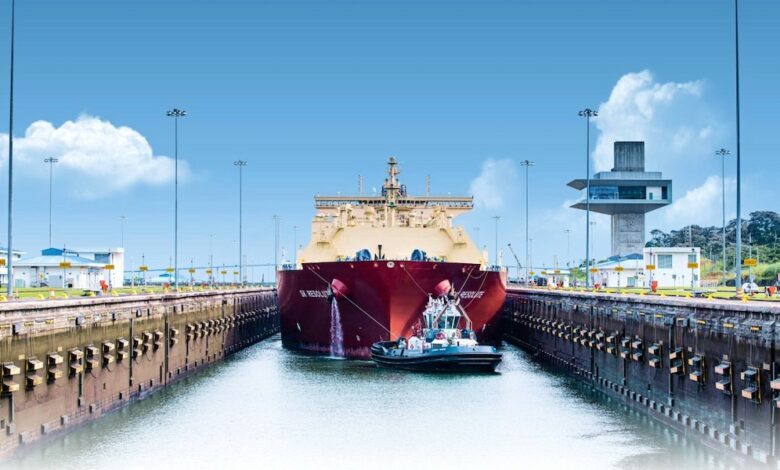VLGC rates surge on Panama Canal cuts

News this week of further daily transit cuts at the Panama Canal has sent a rocket through the already hot VLGC markets.
With containerships expected to take the lion’s share of the available slots on the interoceanic waterway for the next four months at least, other ship types are having to make contingencies, with fleets expected to travel much further, soaking up tonnage.
Nowhere is this more felt than in the LPG markets where a very significant swathe of the VLGC fleet uses the canal regularly to ship gas from the US to Asia.

The Panama Canal Administration warned earlier this week that following the driest October on record, the volume of daily transits will be cut further.
At its maximum, the canal can handle 40 ship transits a day, a figure that has been eroded this year as months of record drought take their toll. In tandem, canal administrators have been forced to cut maximum draft limits for ships transiting the waterway’s larger neopanamax locks by close to 2 m.
In 2023, there has been 41% less rainfall than usual, lowering Gatun Lake to unprecedented levels for this time of year. The lake is the vital slice of freshwater necessary for ships to transit as well as supplying water to more than 50% of the country’s population. Each vessel that transits through the set of locks uses approximately 52m gallons of water. To put this in perspective, normal daily water usage at the Panama Canal surpasses that of all of New York City.
The canal’s administrators will whittle the number of transits from 32 down to just 18 in the coming three months, a figure that will stay until further notice.
“The VLGC sector is likely to see the biggest disruption as it has the highest percentage of its fleet operating through the canal,” a note from investment bank Jefferies stated.
The one-way VLGC voyage between the US Gulf and China takes 30 days at current speeds of 14 knots via the Panama Canal. However, it would take 40 days to go via the Suez Canal or 45 days going around the Cape of Good Hope.
VLGC FFAs have spiked this week following the news from Panama with the Q1 Arabian Gulf to Japan route leaping by more than $25,000 to exceed $110,000 a day.
The rallying VLGC spot market is well supported by a “surging” FFA curve in contango, delays at the canal, and the US – Far East LPG arbitrage, noted Joakim Hannisdahl from Gersemi Asset Management.

With transits becoming a prized commodity, shipping players are forking out top dollar to get their vessels moved across the isthmus. One VLGC owner has paid an all-time record $2.85m at one slot auction in the past week. Average auction prices tend to be around $900,000.
For dry bulk, there is growing consensus that more large ships will look to take alternate routes rather than waiting around at the canal.
“Despite the restrictions at the Panama Canal, the market may find an alternative and use larger ships going round the Cape Horn into the Pacific adding tonne-miles and supporting bigger vessels’ demand,” a recent report from Greece’s Xclusiv Shipbrokers suggested.
The restrictions at the canal have already seen a massive switch for dry bulk. Analysis carried by S&P Global shows the Suez Canal share of US Gulf to Asia shipments have increased to 83% in October versus 23% a year ago.
On top of the weather chaos, Panama has been hit by a series of protests against mining rights in recent weeks, which are set to continue. The protests have seen road closures in key areas of Panama and Colon and while there have been no major disruptions in canal and port operations, port agents at Wilhelmsen warned this week the situation could change if road blockades intensify.
“Please be prepared for potential delays and mis-deliveries of spare parts, as well as disruptions to crew movement if the protests continue in the coming days or week,” Wilhelmsen warned in a note to clients.


Yesterday there was an interesting comment in the Financial Times on the subject:
I find the timing of these “droughts” coinciding with the Panamanians opening a new set of locks that are much much bigger, and thus result in much larger amounts of water being drained from the lake with the passing of each ship… to seem like more than just a coincidence. When commenting about this on another article recently another commenter found a link to a source for rainfall in Panama and there doesn’t appear to be any drought at all. I’ve been through the Panama Canal in both directions a number of times, and the new locks are on a totally different scale. Even with the original set of locks, the amount of water dumped out of the lake for each transit was enormous. The new ones increased that by multiples. This could just be a case of someone having made a bad (or overly optimistic, because they really wanted new locks) calculation and there just not being enough water in the lake to support locks any bigger than the original set. Maybe the rainfall plays a part, but I’d like to see evidence of that before ruling out bad engineering being the root cause.
Dear Bernard,
I agree. I had the same thought when I had to explain these congestions in the Panama Canal to someone not acqainted with seafaring. I explained the new locks and accordingly the additional mass of water from the lakes.
Of course I did and do not know the real figures, but I mentioned the difference of volumes of the old and new locks and suggested this to be a part of the problem.
Thanks and best regards,
Jan ter HAAR